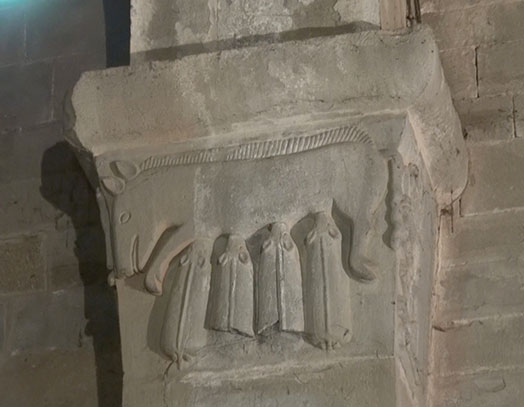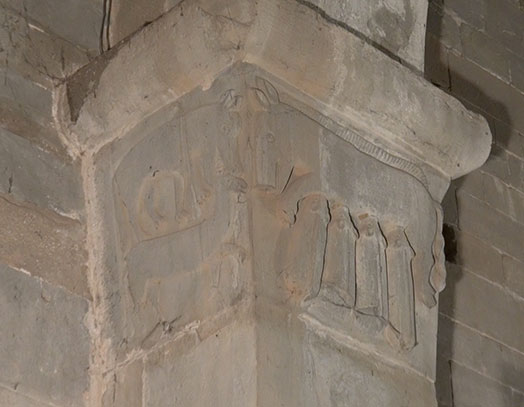THE CAPITAL of the SOW
behind the façade, semipilaster to the right
The Romanesque building phase of the pieve of Gropina was concluded with this capital, according to the scholar Francesco Gandolfo (2003). It was made by a stone-cutter from the Valdarno or the Arezzo area, who also sculpted the capital of the lions and that of the knights in Gropina and was in contact with builders active at the pieve of Arezzo. The principal side shows a sow nursing her four piglets; perpendicular to the wall a wolf holds in his fangs the head of a lamb, who is trying to flee; while the opposite side, facing the entrance, presents the wolf in the act of devouring what seems to be a paw of the lamb. The representations are very immediate and direct, practically without decoration, as was typical of this stone-cutter and is seen in the other two capitals attributed to his hand. His modelling is essential, and, with some exceptions, the relief is sometimes very low and tends to flatten the figures against the background.
Again there are pagan “themes” invested with a Christian meaning. In the pieve of Gropina, as in very many medieval churches, classical antiquity reappears, adapting itself to new sensations, new necessities, but never totally lost and sometimes almost the same as before, as in the images of the wolf and the lamb which remind us of the fables of Aesop and Phaedrus on gratuitous and unjust violence. The lamb, even though capable of arguing against the unjustified accusations of the wolf, is attacked and succumbs to the law of the strongest. In the Christian interpretation the figure of Christ is associated with the innocence and honesty of the lamb, Agnus Dei, who dies as an innocent to redeem evil and sin. The scenes of the capital thus acquire a positive sense, because in coming back to life and defeating death Jesus Christ is victorious, giving mankind the certainty that evil will not prevail.
The depiction of the sow with her suckling piglets on the principal side also has a classical derivation: the god Tiberinus tells Aeneas, just disembarked in Latium, that in the place in which he will see a white sow nursing thirty piglets, there, thirty years hence, Ascanius will found Alba Longa (The Aeneid, VIII, 43-48). Virgil knew very well that the sow was sacred to Ceres, the goddess of fertility and of agriculture, and with this good omen he wished a prosperous future to his hero and above all to the city to be founded. The new Christian interpretation was based on the act of nourishing: as the labours of agriculture nourish man in the four seasons of the year (the four piglets), so the Word of God noursihes and fortifies souls. Therefore the entire capital is linked to the dominant motif displayed in the pieve of Gropina: the salvation of the soul by means of an elevating spiritual journey marked by obstacles and threats, but able to lead to purification and light.


